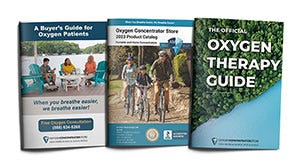Oxygen Therapy Delivery Systems
Many respiratory diseases require special equipment for treatment and therapy. With everything from asthma inhalers to oxygen concentrators, the list of equipment can be intimidating. We'll help you navigate through it.
Technical Explanation: A concentrator has two cylinders filled with zeolite which selectively adsorbs the nitrogen in the air. In each cycle, air flows through one cylinder at a pressure where the nitrogen molecules are captured by the zeolite, while the other cylinder is vented off to ambient atmospheric pressure allowing the captured nitrogen to dissipate. Typical units have cycles of around 20 seconds, and allow for a continuous supply of oxygen at a flow rate of up to approximately 10 liters per minute (LPM) at concentrations anywhere from 25% to 95%. This process is called the pressure swing adsorption(PSA) cycle.
Overview of Oxygen Equipment/Delivery Systems
How Oxygen Concentrators Work:
Oxygen Concentrators are medical devices that deliver medical grade oxygen (greater than 88% pure oxygen) to a patient via either a nasal cannula or mask. Air generally contains mostly nitrogen and only about 21% oxygen. Concentrators remove the nitrogen and "concentrate" the oxygen. Oxygen concentrator output is generally measured in LPM (liters per minute). A patient on oxygen therapy receives air with a higher concentration of oxygen than the ambient air. As opposed to a compressed oxygen tank, which delivers some amount of pure oxygen, a concentrator removes other components from the air, achieving the same effect more safely and at a lower cost. It’s a pretty straightforward idea, but how is it accomplished?
Technical Explanation: A concentrator has two cylinders filled with zeolite which selectively adsorbs the nitrogen in the air. In each cycle, air flows through one cylinder at a pressure where the nitrogen molecules are captured by the zeolite, while the other cylinder is vented off to ambient atmospheric pressure allowing the captured nitrogen to dissipate. Typical units have cycles of around 20 seconds, and allow for a continuous supply of oxygen at a flow rate of up to approximately 10 liters per minute (LPM) at concentrations anywhere from 25% to 95%. This process is called the pressure swing adsorption(PSA) cycle.
Delivery Systems Specifications:
Key specifications for an oxygen concentrator are as follows:- Electrical / Power Requirements: Standard home concentrators run only on AC power. A "portable oxygen concentrator" by definition will run on AC power, DC power and batteries. Most home concentrators in the United States will only run on 110 Volts AC (often listed in specifications as 120 V AC +/- 10%)
- Weight: The weight of home concentrators will vary from the lightest on the market today is 31 pounds to older units that can weigh more the 50 pounds.
- Dimensions: Dimensions will vary with both manufacturers style and the age of the unit but all units are basically a "cube" shape of approximately 12 - 15" wide by 9" - 15" deep by 23" -28" tall.
- Noise Level: Noise level on units is measured in decibels. The newer "quiet" units are approximately 45 decibels, older units typically do not have the same sound baffling and are slightly louder( 50 - 60 decibels). Additionally, as units age, the compressors can become louder. As a comparison, a "library whisper" is considered to be approximately 30 decibels and "normal conversation" is considered to be in the 60-70 decibel range.
- Temperature Operating Range: Home oxygen concentrators are specified to operate in a normal home environment typically between 45 degrees F and 90 degrees F. Outside of these ranges, the unit may not function properly.
- Altitude Operating Range: Altitude specifications for home concentrators vary slightly. Most are specified to operate up to 7500 - 8000 feet. This specification limitation is because the oxygen percentage in the air at higher altitudes decreases.
- Oxygen Concentration: Any oxygen concentrator should deliver "medical grade" oxygen. Medical grade is typically defined as 88% pure oxygen and above. Most new concentrators are specified to have between 92 - 95% pure oxygen (+/- 3%)
- Warranty: Warranties vary with manufacturer. Most manufacturers have a 3 or 5 year warranty. Patients should clarify both the length of any warranty and the start date of the warranty as some manufacturers start the warranty when the unit is shipped to the retailer.
Updated: August 1, 2023

